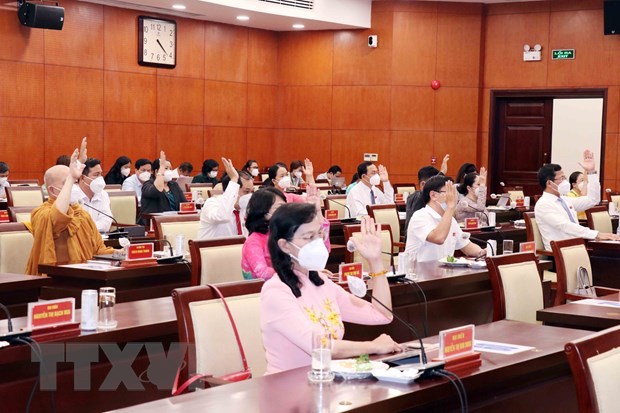 Society
Society


|
| Delegates vote on a resolution at the HCM City People’s Council on Thursday. — VNA/VNS Photo Xuân Khu |
HCM CITY — The HCM City People’s Council has passed a resolution on socio-economic tasks for 2022 and the next five years to help “adapt safely and flexibly and effectively contain the outbreak, improve the quality of urban government, support businesses, and improve the business climate.”
Speaking at the HCM City People’s Council on Thursday, Nguyễn Thị Lệ, chairwoman of the People’s Committee, said the tasks include making the city a smart city with a focus on digital economy and an international financial hub for Southeast Asia by 2030 and for Asia by 2045.
It also targets per capita income of US$13,000 by 2030 and $37,000 by 2045.
Its economy has expanded significantly in the past five years after growing by an average of 6.41 per cent a year.
Due to the impacts of the pandemic, the economy has for the first time seen negative growth this year (minus 6.78 per cent).
But its revenues of VNĐ370 trillion ($15.92 billion) have exceeded the year’s target marginally.
In recent years its collections accounted for 25 - 27 per cent of the country’s total revenues.
The city also attracted more than $5.8 billion worth of foreign direct investment this year, while foreign remittances rose by nearly 9 per cent to an estimated $6.6 billion.
The People’s Council has divided a five-year economic recovery plan into two phases.
Until the end of 2022 the city will continue to focus on pandemic prevention while also reviving the economy and supply chains, creating employment and ensuring workers’ welfare.
From 2023 to 2025 it will resolve problems faced by the city such as traffic jams, flooding, air pollution, and others.
2022 targets:
Revenue collections of more than VNĐ386 trillion ($16.66 billion), a 5.9 per cent increase
Economic growth of 6 - 6.5 per cent with the services sector accounting for more than 60 per cent
Labour productivity growth of 7 per cent
Number of workers with vocational training to account for 86 per cent of the total number
20.4 doctors and 42 hospital beds per 10,000 people
Unemployment rate of under 4 per cent
300,000 jobs
Reduction of poverty rate by 0.35 per cent and near-poor households by 0.2 per cent
100 per cent of children aged three to 18 to attend school and a ratio of 300 classrooms per 10,000 students
Fertility rate of at least 1.39 children per woman
Transport uses to account for 13.32 per cent of urban land
Housing per capita of 21.2 square metres and total housing area of 6.6 million square metres
Urban greenery area of not less than 0.57 square metre per capita.
To be among the top five cities in the provincial competitiveness index
Reduce traffic-related deaths and large fires by at least 5 per cent. VNS




